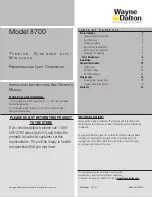
CBOX936
INSTALLATION AND PROGRAMMING MANUAL
7
PEDESTRIAN TRAFFIC
The operator is intended for installation only on gates used
for vehicles. Pedestrians must be supplied with a separate
access opening. The pedestrian access opening shall be
designed to promote pedestrian usage. Locate the gate
such that persons will not come in contact with the vehicular
gate during the entire path of travel of the vehicular gate.
GATE CLEARANCES
The gate must be installed in a location so that enough
clearance is supplied between the gate and adjacent
structures when opening and closing to reduce entrapment
risk. Swinging gates shall not open into public access areas.
GATE CONDITION
The gate must be properly installed and work freely in both
directions prior to gate operator installation. Don’t change
operator force sensitivity settings to compensate for an
improperly installed, improperly functioning, or damaged
gate.
GATE CONTROL ACCESS
Permanently mounted controls intended for user activation
must be located at least 1.83 m (6 ft) away from any moving
part of the gate and where the user is prevented from
reaching over, under, around or through the gate to operate
the controls. Exception: Emergency access controls only
accessible by authorized personnel (e.g. fire, police, EMS)
may be placed at any location in the line-of-sight of the gate.
STOP/START BUTTON LOCATION
The Stop and/or Reset button must be located in the line-
of-sight of the gate. Activation of the reset control shall not
cause the operator to start.
WARNING SIGNS
A minimum of two (2) WARNING SIGNS shall be installed,
in the area of the gate. Each placard is to be visible by
persons located on the side of the gate on which the placard
is installed.
PHOTO EYE SENSORS
For gate operators using a non-contact sensor (Photo Eye):
• See instructions on the placement of non-contact sensors
for each type of application.
• Care shall be exercised to reduce the risk of nuisance
tripping, such as when a vehicle, trips the sensor while the
gate is still moving.
• One or more non-contact sensors shall be located where
the risk of entrapment or obstruction exists, such as the
perimeter reachable by a moving gate or barrier.
CONTACT SENSORS (EDGE)
For a gate operator utilizing a contact sensor (Edge):
• One or more contact sensors shall be located where
entrapment or obstruction risks exists, such as at the
leading edge, trailing edge, and post-mounted both inside
and outside of a vehicular horizontal slide gate.
• A hardwired contact sensor shall be located and its wiring
arranged so that the communication between the sensor
and the gate operator is not subjected to mechanical
damage.
• A wireless device such as one that transmits radio frequency
(RF) signals to the gate operator for entrapment protection
functions shall be located where the transmission of
the signals are not obstructed or impeded by building
structures, natural landscaping or similar obstruction. A
wireless device shall function under the intended end-use
conditions.
• One or more contact sensors shall be located on the inside
and outside leading edge of a swing gate. Additionally, if
the bottom edge of a swing gate is greater than 152 mm
(6 in) but less than 406 mm (16 in) above the ground at any
point in its arc of travel, one or more contact sensors shall
be located on the bottom edge.
USE OF VEHICLE DETECTORS
Use of vehicle detectors (loop detectors) is strongly
encouraged to prevent damage to vehicles caused by gates
closing on them. This is not considered to be a safety item as
vehicle detectors cannot provide protection to pedestrians. In
some situations, photoelectric devices may be used as vehicle
detectors, but should be wired accordingly.
GATE CONSTRUCTION & SAFETY
Gate construction plays a very important role in ensuring the
safety of any automated gate system. The standard for gate
construction is ASTM F2200. Below are key areas to address
safety in gate design. For complete information consult the
standard. Copies of the standard are available at:
https://www.astm.org/Standards/F2200.htm
Another source of information is available from DASMA, the
Door and Access System Manufacturer’s Association. The
Association publishes Technical Data Sheets, one of which
concerns ASTM F2200. For more information, see:
h t t p : / / w w w. d a s m a . c o m / P D F / P u b l i c a t i o n s /
TechDataSheets/OperatorElectronics/TDS370.pdf
www.ApolloGateOpeners.com | (800) 878-7829 | [email protected]








































